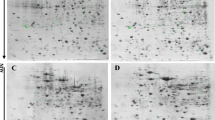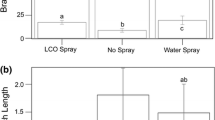Abstract
The establishment of a symbiotic interaction involves a signal exchange between the host legume (flavonoids) and the nitrogen-fixing rhizobia (nodulation factors (NFs)). Likewise, abiotic stress conditions, such as salinity and drought, strongly reduce the nodulation process, possibly affecting also the signal exchange. In this work we characterized the structure and biological activity of NFs produced by Bradyrhizobium japonicum USDA 138 under control, salt, and osmotic stress conditions. This strain is the most widely used in Argentine soybean culture; under control conditions, it produces a mixture of four types of NFs (V(C16:0,MeFuc), V(C18:1,MeFuc), IV(C18:1), and V(C18:1,Ac,MeFuc)). Interestingly, under stress conditions, this strain produces new types of NFs, one common for both stress conditions (V(C16:1,MeFuc)) and another one only present under salt stress (IV(C18:1,MeFuc)). All mixtures of NFs, extracted from control, salt, and osmotic stress conditions, showed biological activity in soybean plants, such as root hair deformation, and the radical application of purified NFs induced systemic differences in dry matter accumulation. The inoculation of soybean with genistein-induced bacteria cultured under both control and stress conditions had a positive effect on the number of nodules formed and in some cases on dry matter accumulation. These responses are not related to changes in chlorophyll fluorescence or greenness index.






Similar content being viewed by others
References
Almaraz JJ, Zhou X, Souleimanov A, Smith D (2007) Gas exchange characteristics and dry matter accumulation of soybean treated with Nod factors. J Plant Physiol 164:1391–1393
Bais P, Weir L, Perry G, Gilroy S, Vivanco JM (2006) The role of root exudates in rhizosphere interactions with plants and other organisms. Annu Rev Plant Phys 57:233–266
Bouhmouch I, Mouhsine BS, Brhada F, Aurag J (2005) Influence of host cultivars and Rhizobium species on the growth and symbiotic performance of Phaseolus vulgaris under salt stress. J Plant Physiol 162:1103–1113
Broughton J, Jabbouri D, Perret X (2000) Keys to symbiotic harmony. J Bacteriol 182:5641–5652
Broughton W, Dilworth M (1971) Control of leghaemoglobin synthesis in snake beans. Biochem J 125:1075–1080
Cárdenas L, Holdaway-Clarke TL, Sanchez F, Quinto C, Feijo JA, Kunkel JG, Helper PK (2000) Ion changes in legume root hairs responding to Nod factors. Plant Physiol 123:443–452
Carlson RW, Sanjuan J, Bhat R, Glushka J, Spaink H, Wijijes AHM, van Brussel AAN, Stokkermans TJW, Peters NK, Stacey G (1993) The structures and biological activities of the lipo-oligosaccharide nodulation signals produced by type I and II strains of Bradyrhizobium japonicum. J Biol Chem 24:18372–18381
Cesco S, Mimmo T, Tonon G, Tomasi N, Pinton R, Terzano R, Neumann G, Weisskopf L, Renella G, Landi L, Nannipieri P (2012) Plant-borne flavonoids released into the rhizosphere: impact on soil bio-activities related to plant nutrition. A review. Biol Fertil Soils 48:123–150
Dardanelli MS, Manyani H, Gonzalez Barroso S, Rodriguez Carvajal MA, Gil Serrano AM, Espuny Gomez MR, López-Baena F, Bellogin Izquierdo RA, Megías Guijo M, Ollero Márquez FJ (2009) Effect of the presence of the plant growth promoting rhizobacterium (PGPR) Chryseobacterium balustinum Aur9 and salt stress in the pattern of flavonoids exuded by soybean roots. Plant Soil 328:483–493
Duzan H, Mabood F, Zhou X, Souleimanov A, Smith D (2005) Nod factor induces soybean resistance to powdery mildew. Plant Physiol Bioch 43:1022–1030
Elkan GH (1992) Taxonomy of the rhizobia. Can J Microbiol 38:446–450
Elsheikh E, Wood M (1995) Nodulation and N2 fixation by soybean inoculated with salt-tolerant rhizobia or salt-sensitive bradyrhizobia in saline soil. Soil Biol Biochem 27:657–661
Estévez AJ, Fernández-Córdoba F, Soria Diaz ME, Manyani H, Gil Serrano AM, Thomas-Oates J, Van Brussel AAN, Dardanelli MS, Sousa Martin C, Megías Guijo M (2009) Different and new Nod factors produced by Rhizobium tropici CIAT899 following Na+ stress. Fems Microbiol Lett 293:220–231
Felle Hubert H, Kondorosi E, Kondorosi A, Schultze M (2000) How alfalfa root hairs discriminate between Nod factors and oligochitin elicitors. Plant Physiol 124:1373–1380
Graham PH, Vance CP (2000) Nitrogen fixation in perspective: an overview of research and extension needs. Field Crop Res 65:93–106
Guasch-Vidal B, Estévez J, Dardanelli MS, Soria-Díaz ME, Fernández de Cordoba F, Balog C, Manyani H, Gil-Serrano A, Thomas-Oates J, Hensbergen PJ, Deelder AM, Megias M, van Brussel AAN (2012) High NaCl concentrations induce the nod genes of Rhizobium tropici CIAT899 in the absence of flavonoid inducers. Mol Plant Microbe Interact 26:451–460
Khan W, Prithiviraj B, Smith D (2008) Nod factor [Nod Bj V (C18:1, MeFuc)] and lumichrome enhance photosynthesis and growth of corn and soybean. J Plant Physiol 165:1342–1351
Kuykendall LD, Saxena B, Devine TE, Udell SE (1992) Genetic diversity in Bradyrhizobium japonicum Jordan 1982 and a proposal for Bradyrhizobium elkanii sp.nov. Can J Microbiol 38:501–505
Morón B, Soria-Díaz ME, Ault J, Verroios G, Noreen S, Rodríguez-Navarro DN, Gil-Serrano A, Thomas-Oates J, Megías M, Sousa C (2005) Low pH changes the profile of nodulation factors produced by Rhizobium tropici CIAT899. JOCB 12:1029–1040
Muñoz N, Robert G, Melchiorre M, Racca R, Lascano R (2012) Saline and osmotic stress differentially affects apoplastic and intracellular reactive oxygen species production, curling and death of root hair during Glycine max L.–Bradyrhizobium japonicum interaction. Environ Exp Bot 78:76–83
Oldroyd G, Downie A (2008) Coordinating nodule morphogenesis with rhizobial infection in legumes. Annu Rev Plant Phys 59:519–546
Ovtsyna AO, Rademaker GJ, Esser E, Weinman J, Rolfe BG, Tikhonovich IA, Lugtenberg BJJ, Thomas-Oates JE, Spaink HP (1999) Comparison of characteristics of the nodX genes from various Rhizobium leguminosarum strains. Mol Plant Microbe In 12:252–258
Pan B, Smith D (2000) Genistein preincubation of Bradyrhizobium japonicum cells improves strain competitiveness under greenhouse, but not field conditions. Plant Soil 223:229–234
Sanjuan J, Russell WC, Spaink HP, Bhat UR, Barbour WM, Glushka J, Stacey G (1992) A 2-O-methylfucose moiety is present in the lipo-oligosaccharide nodulation signal of Bradyrhizobium japonicum. P Natl Acad Sci USA 89:8789–8793
Singleton P, Bohlool B (1984) Effect of salinity on nodule formation by soybean. Plant Physiol 74:72–76
Souleimanov A, Prithiviraj B, Smith D (2002) The major Nod factor of Bradyrhizobium japonicum promotes early growth of soybean and corn. J Exp Bot 53:1929–1934
Spaink HP (1995) The molecular basis of infection and nodulation by rhizobia: the ins and outs of sympathogenesis. Annu Rev Phytopathol 33:345–368
Spaink HP, Aarts A, Stacey G, Bloemberg GV, Lugtenberg BJ, Kennedy EP (1992) Detection and separation of Rhizobium and Bradyrhizobium Nod metabolites using thin-layer chromatography. Mol Plant Microbe In 5:72–80
Spaink HP, Sheeley DM, van Brussel AAN, Glushka J, York WS, Tak T, Geiger O, Kennedy EP, Reinhold VN, Lugtenberg BJJ (1991) A novel highly unsaturated fatty acid moiety of lipo-oligosaccharide signals determines host specificity of Rhizobium. Nature 354:125–130
Stacey G (1995) Bradyrhizobium japonicum nodulation genetics. Fems Microbiol Lett 127:1–9
Stacey G, Luka S, Sanjuan J, Banfalvi Z, Nieuwkoop AJ, Chun JY, Forsberg LS, Carlson R (1994) nodZ, a unique host-specific nodulation gene, is involved in the fucosylation of the lipooligosaccharide nodulation signal of Bradyrhizobium japonicum. J Bacteriol 176:620–633
Stokkermans TJW, Ikeshita S, Cohn J, Carlson RW, Stacey G, Ogawa T, Peters NK (1995) Structural requirements of synthetic and natural product lipochitin oligosaccharides for induction of nodule primordia on Glycine soja. Plant Physiol 108:1587–1595
Vincent J (1970) A manual for the practical study of the root-nodule bacteria. Blackwell Scientific Publications, Oxford
Acknowledgments
This work was supported by grants from Red Iberoamericana de Fertilizantes Biológicos para la Agricultura y el Medio Ambiente (BIOFAG) and Instituto Nacional de Tecnología Agropecuaria (INTA). We thank Esaú Megías Saavedra, Laura Romero Cuadrado, Francisco Javier López Baena, and Francisco Javier Ollero Márquez for the technical assistance.
Author information
Authors and Affiliations
Corresponding authors
Electronic supplementary material
Below is the link to the electronic supplementary material.
ESM 1
(PDF 125 kb)
Rights and permissions
About this article
Cite this article
Muñoz, N., Soria-Díaz, M.E., Manyani, H. et al. Structure and biological activities of lipochitooligosaccharide nodulation signals produced by Bradyrhizobium japonicum USDA 138 under saline and osmotic stress. Biol Fertil Soils 50, 207–215 (2014). https://doi.org/10.1007/s00374-013-0843-1
Received:
Revised:
Accepted:
Published:
Issue Date:
DOI: https://doi.org/10.1007/s00374-013-0843-1




